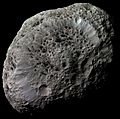Hyperion (moon) facts for kids
Hyperion is a fascinating moon that orbits the giant planet Saturn. It's quite unique among the many moons in our Solar System. Scientists first spotted Hyperion on September 16, 1848. It was discovered by three astronomers: William Cranch Bond, George Phillips Bond, and William Lassell.
Unlike most moons, Hyperion isn't round like a ball. It has an irregular, lumpy shape. Imagine a giant space sponge, and you'll have a good idea of what Hyperion looks like! It's the second biggest moon in our solar system that isn't round. The largest non-round moon is Proteus, which orbits Neptune.
Hyperion also has a very unusual way of spinning. Its rotation is called "chaotic." This means its axis of rotation wobbles and tumbles unpredictably. This is very different from how the Earth and our own Moon spin, or how most other moons in the Solar System rotate.
Contents
Hyperion's Unique Shape and Surface
Hyperion stands out because of its odd shape. Most large moons are pulled into a round, spherical shape by their own gravity. But Hyperion is different. It's more like a potato or a giant cosmic rock.
Its surface is covered in many deep craters. These craters make it look like a sponge or a honeycomb. This strange appearance is partly due to its low density. Hyperion is thought to be made mostly of water ice with some rock. It might even have empty spaces inside, making it very porous.
How Hyperion Spins (Chaotic Rotation)
One of the most amazing things about Hyperion is its chaotic rotation. For most moons, their spin is stable. They always show roughly the same face to their planet, or they spin smoothly.
But Hyperion tumbles and wobbles as it orbits Saturn. Its spin axis keeps changing direction. This makes it impossible to predict exactly how it will be oriented at any given time. This chaotic spin is caused by its irregular shape and the strong gravitational pull of nearby Titan, Saturn's largest moon.
Discovering Hyperion
Hyperion was discovered in 1848. This was a time when astronomers were using powerful new telescopes to explore the outer Solar System. The moon was first seen by William Cranch Bond and his son George Phillips Bond at the Harvard College Observatory.
On the very same day, William Lassell, an English astronomer, also discovered Hyperion independently. This shows how exciting and competitive astronomy was in the 19th century.
Exploring Hyperion with Space Probes
Scientists have learned a lot about Hyperion from space missions. The Cassini space probe, which orbited Saturn for many years, flew past Hyperion several times.
These close flybys allowed Cassini to take detailed pictures of Hyperion's strange surface. It also collected data that helped scientists understand its composition and its unusual chaotic rotation. The images from Cassini really showed us just how unique this moon is.
Images for kids
See also
 In Spanish: Hiperión (satélite) para niños
In Spanish: Hiperión (satélite) para niños




